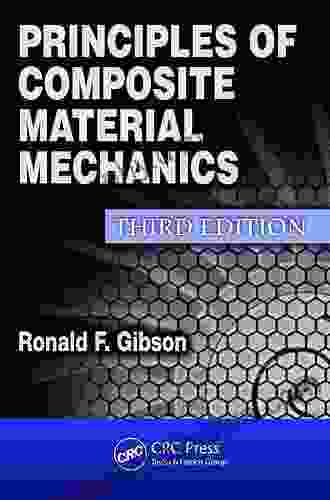Unveiling the Principles of Composite Material Mechanics: A Comprehensive Guide for Mechanical Engineers

Composite materials have revolutionized the field of mechanical engineering, offering unparalleled strength, weight reduction, and design flexibility. Understanding the principles of composite material mechanics is essential for engineers to harness the full potential of these advanced materials.
Fundamentals of Composite Materials
Composite materials are formed by combining two or more distinct materials, with one material acting as the matrix and the other as the reinforcement. This combination results in a material with properties superior to its individual constituents.
4.5 out of 5
| Language | : | English |
| File size | : | 32016 KB |
| Screen Reader | : | Supported |
| Print length | : | 683 pages |
The matrix material provides the composite with its shape and overall structure. Common matrix materials include polymers, metals, and ceramics. The reinforcement material, usually fibers or particles, enhances the composite's strength and stiffness. Carbon fiber, glass fiber, and ceramic fibers are widely used as reinforcements.
Types of Composite Materials
Composites can be classified based on their matrix material:
- Polymer Matrix Composites (PMCs): The most common type of composite, PMCs utilize a polymer matrix, such as epoxy, polyester, or vinyl ester. They offer high strength-to-weight ratios and are widely used in aerospace, automotive, and marine applications.
- Metal Matrix Composites (MMCs): MMCs have a metal matrix, such as aluminum, magnesium, or titanium. They combine high strength and stiffness with thermal conductivity, making them suitable for high-temperature environments.
- Ceramic Matrix Composites (CMCs): CMCs utilize a ceramic matrix, such as silicon carbide or zirconia. They offer exceptional strength and heat resistance, making them ideal for aerospace and energy applications.
Mechanical Behavior of Composites
The mechanical behavior of composites is influenced by their constituent materials, microstructure, and manufacturing process. Understanding the following mechanical properties is crucial:
- Tensile Strength: The ability of the composite to withstand axial loads without breaking.
- Compressive Strength: The ability to resist compressive loads without collapsing.
- Flexural Strength: The material's resistance to bending forces.
- Shear Strength: The ability to withstand shear forces that cause sliding.
- Fracture Toughness: The material's resistance to crack propagation.
Applications of Composite Materials
Composite materials have found widespread applications across industries, including:
- Aerospace: Aircraft structures, satellite components, and rocket nozzles.
- Automotive: Car bodies, drive shafts, and suspension systems.
- Marine: Boat hulls, masts, and underwater components.
- Medical: Surgical implants, prosthetic devices, and dental restorations.
- Sports Equipment: Golf clubs, tennis rackets, and bicycle frames.
Design Considerations
When designing with composite materials, engineers must consider the following factors:
- Material Selection: Choosing the right matrix and reinforcement materials based on the desired properties and application.
- Layup Design: Optimizing the fiber orientation and ply thickness to achieve specific strength and stiffness characteristics.
- Manufacturing Process: Selecting the most appropriate fabrication technique to ensure the desired composite properties.
- Testing and Inspection: Performing rigorous mechanical tests and non-destructive inspections to validate the composite's performance.
Advancements in Composite Material Mechanics
Ongoing research and development in composite material mechanics are pushing the boundaries of this field:
- Nanocomposites: Composites reinforced with nanoscale materials, offering enhanced mechanical and functional properties.
- Biocomposites: Composites derived from renewable and sustainable materials, such as plant fibers and biopolymers.
- Multi-Material Composites: Composites combining multiple matrix and reinforcement materials for tailored properties.
- Additive Manufacturing (3D Printing): Enabling the fabrication of complex composite structures with precision and speed.
Composite material mechanics is a complex and dynamic field that plays a critical role in modern engineering. Understanding the principles, applications, and advancements in this area empowers mechanical engineers to create innovative and high-performance products that meet the challenges of today's industries.
Our comprehensive guide provides a thorough foundation for exploring the world of composite material mechanics. Whether you are a student, researcher, or practicing engineer, this resource will guide you towards unlocking the full potential of these advanced materials.
4.5 out of 5
| Language | : | English |
| File size | : | 32016 KB |
| Screen Reader | : | Supported |
| Print length | : | 683 pages |
Do you want to contribute by writing guest posts on this blog?
Please contact us and send us a resume of previous articles that you have written.
 Book
Book Novel
Novel Page
Page Chapter
Chapter Text
Text Story
Story Genre
Genre Reader
Reader Library
Library Paperback
Paperback E-book
E-book Magazine
Magazine Newspaper
Newspaper Paragraph
Paragraph Sentence
Sentence Bookmark
Bookmark Shelf
Shelf Glossary
Glossary Bibliography
Bibliography Foreword
Foreword Preface
Preface Synopsis
Synopsis Annotation
Annotation Footnote
Footnote Manuscript
Manuscript Scroll
Scroll Codex
Codex Tome
Tome Bestseller
Bestseller Classics
Classics Library card
Library card Narrative
Narrative Biography
Biography Autobiography
Autobiography Memoir
Memoir Reference
Reference Encyclopedia
Encyclopedia Alexandra Kui
Alexandra Kui Alix Lee
Alix Lee Ashvin Raj
Ashvin Raj Jen Arena
Jen Arena Amie Jane Leavitt
Amie Jane Leavitt Amanda Walton
Amanda Walton David Z Albert
David Z Albert Ali Novak
Ali Novak Alta Macadam
Alta Macadam Allen Ginsberg
Allen Ginsberg Alonso De Contreras
Alonso De Contreras Amber Hendricks
Amber Hendricks Iain Campbell
Iain Campbell Alexander William Kinglake
Alexander William Kinglake Sarah Crossan
Sarah Crossan Tracey Turner
Tracey Turner Mark Grabowski
Mark Grabowski Beth Younger
Beth Younger Allan Sand
Allan Sand Drethi Anis
Drethi Anis
Light bulbAdvertise smarter! Our strategic ad space ensures maximum exposure. Reserve your spot today!
 Ryan FosterFollow ·12.6k
Ryan FosterFollow ·12.6k Sam CarterFollow ·12.3k
Sam CarterFollow ·12.3k Jaylen MitchellFollow ·15.6k
Jaylen MitchellFollow ·15.6k Italo CalvinoFollow ·17k
Italo CalvinoFollow ·17k Anthony WellsFollow ·13.8k
Anthony WellsFollow ·13.8k Fletcher MitchellFollow ·14k
Fletcher MitchellFollow ·14k Leo MitchellFollow ·12k
Leo MitchellFollow ·12k Samuel Taylor ColeridgeFollow ·7.5k
Samuel Taylor ColeridgeFollow ·7.5k

 Darnell Mitchell
Darnell MitchellMathematician's Odyssey to Uncover the Origins of Numbers
In his captivating new...

 Milton Bell
Milton BellUnlock the Power of Profiting Without Property: Your...
Are you ready to embark on a...

 Arthur Mason
Arthur MasonUnlock the Minds of Mathematical Giants: The Lives of the...
Mathematics, the language of...

 Fernando Pessoa
Fernando PessoaUnlock the Magic of the Big Apple: New York City for...
Unleash the Adventures in New...

 H.G. Wells
H.G. WellsAddiction Counselor Exam Secrets Study Guide: Your...
Embark on a...
4.5 out of 5
| Language | : | English |
| File size | : | 32016 KB |
| Screen Reader | : | Supported |
| Print length | : | 683 pages |














